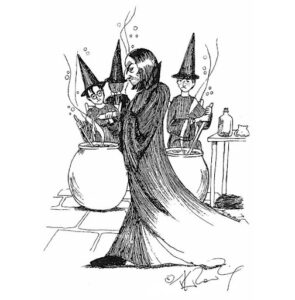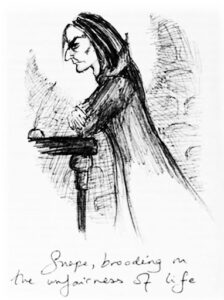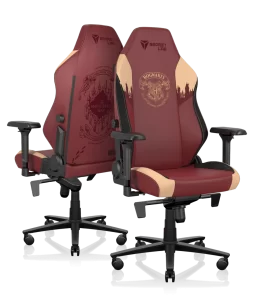Revamping Trocar: Ink Black Vampires and the Half-Blood Prince
by Dr. Beatrice Groves
In Harry Potter, the reader is constantly teased with the idea that vampires might be about to play a major role in the story. There are vampires hanging around pubs in Minsk and blood-flavored lollipops sold in Honeydukes to cater to the tastes of vampires who live rather closer to home. The wizarding world is clearly fascinated by vampires, and we read of many books published about them: the new book on vampires that Quirrell claims to be purchasing in Diagon Alley, Worple’s vampiric biography Blood Brothers: My Life Amongst the Vampires, Xenophilius Lovegood’s very long (though admittedly suppressed) article on Scrimgeour’s purported vampirism, and Lockhart’s Voyages with Vampires (which is his most frequently mentioned work). The traditional tropes of vampirism are present from the opening of the series – from large cloves of garlic being used to ward off evil to Snape “swooping around like an overgrown bat” (SS 288). Dracula’s transformation into a bat is one of the most famous examples of therianthropy, and (in addition to being one of the sources for the concept of Animagi more generally) it is particularly relevant for Snape, who glides about “like a large and malevolent bat” (CoS 193) and is found to look “just as much like an overgrown bat as ever” in Harry Potter and the Half-Blood Prince (179). In Harry Potter and the Goblet of Fire, we find Ron muttering about how Snape might even be able to “turn himself into a bat” (566), and in Harry Potter and the Deathly Hallows, this almost comes true when Snape flies out of a window: “a huge, batlike shape flying through the darkness toward the perimeter wall” (599).
The Ink Black Heart is the most gothic of Rowling’s works to date, and along with centering on an overgrown, Victorian necropolis and opening in October, it includes another classic gothic trope (familiar from Harry Potter): that of a bat transforming into a vampire. When Robin enters Drek’s Game, she is met by one among the graves of Highgate Cemetery:
Suddenly a bat swooped low over her character and transformed into a vampire, blocking her path. The vampire, who looked weak and weedy, stood panting, his hand on his chest, before ‘speaking’ to her, the dialogue appearing across its chest.
Mind if I suck on an artery?” (IBH 319)
This is a comic vampire – washed out and rather polite – and this humor links it to the explicitly comic vampires of Harry Potter. Vampirism is almost always part of a joke at Hogwarts – from hammy performances of Voyages with Vampires, Luna’s matter-of-fact assertion that the Minister of Magic is a vampire, and the grandiose claim of the Leaky Cauldron dishwasher that he’s really a vampire hunter to the comic scene in which a vampire does finally, actually appear. Sanguini – the celebrity guest at Slughorn’s Christmas party – is framed in entirely unserious terms. The dangerous erotic allure of the traditional pop-culture vampire is wittily undercut when Sanguini starts edging – with “a rather hungry look in his eye” – toward the “gaggle of girls” who are eyeing him up excitedly only to be deflected from his devious purposes by Worple stuffing a pasty into his hand (HBP 316). When a pasty forms an acceptable substitute for virgins’ throats in slaking Sanguini’s bloodthirsty desires, we know that the vampire’s traditionally transgressive sex appeal has been thoroughly defanged by comedy.
Sanguini’s cameo is one of a number of links between Half-Blood Prince, the sixth novel of the Harry Potter series, and The Ink Black Heart, the sixth novel of the Strike series (a connection I’ve discussed in depth here; and see also the discussion at Hogwarts Professor and here at Mugglenet). In The Ink Black Heart, as in Harry Potter, the appearance of a vampire is teased to the readership – this time by an article (which appeared shortly before the novel’s publication) on Robert Galbraith’s home page. This article drew readers’ attention to the most gothic stories connected with Highgate Cemetery: the necropolis that forms the setting for the novel and both of the texts within the text (the cartoon and the game). One such story featured a mythic figure called “the Highgate Vampire”:
The cemetery has been the setting for other stories of magicians and monsters. Once the cemetery fell into disuse and became overgrown, various ghost stories began to accrue around it. In the late 1960s and early seventies, rumours circulated about a strange grey figure, seven foot high with red eyes. Claims were made that this figure was feeding on small animals in the cemetery, leaving puncture wounds in their necks, and it was in fact a King Vampire bought [sic] to this country many centuries ago. According to the story modern magicians and occultists were trying to resurrect it. The cemetery became a focus for vampire hunters who claimed to discover a lot of evidence of occult ritual activity, and the police were kept busy defending the graves from determined ghost hunters, exorcists and some grisly acts of vandalism until the friends took over the cemetery and secured the site.
Once we’d read The Ink Black Heart, however, this appeared to be a piece of misdirection, for the Highgate Vampire never appears in the cartoon “The Ink Black Heart.” Indeed, it turns out that the author – Edie Ledwell – had been rather dismissive about the idea of including this vampire when her cowriter suggested it to her: “Edie fort it was corny, ’avin’ a vampire” (IBH 616). The author’s offhand quashing of this vampire (a vampire that the setting had led readers to expect) has a ring of familiarity about it. For there was, as Rowling has noted, a persistent fan theory that Snape might turn out to be a vampire, and although Rowling’s illustrations appeared to encourage this reading, the author herself persistently quashed the theory (see, for example, the World Book Day chat from 2004, her 2005 interview with MuggleNet and the Leaky Cauldron, and her writing on vampires for WizardingWorld.com).
But the parallel goes much deeper. For in The Ink Black Heart (just as in Harry Potter), while the literal vampire is suppressed, it draws attention to the concept of vampirism, which is an important trope in the story as a whole. In both texts, the actual vampire turns out to be unimportant or nonexistent – Sanguini is a bit part character, Snape is not a vampire, and Edie refuses, likewise, to allow a vampire character to play any role in her cartoon – but in The Ink Black Heart, just as in Harry Potter, the importance of this emanation of the undead hangs like a miasma over the story as a whole.
Firstly, it is an important clue. Josh tells Strike and Robin about his conversation with Edie:
‘I wanted to put the vampire in. They fort there was a vampire in the real cemetery, in the seventies. Edie fort it was corny, ’avin’ a vampire, but I drew ’im so she could see what I was finking. I wanted ’im to be inept, like, tryna kill tourists but never gettin’ enough blood to live on, so ’e was, like, weak an’ feeble…’
‘Did you write notes on the drawing, of how you saw the character?’
‘Yeah,’ said Josh, ‘I did. On the back. Bu’ I left the sketch downstairs, in
one of the art rooms, an’ it disappeared.’” (IBH 616)
North Grove, the place from which this vampire picture is stolen, is not as obviously creepy as Highgate Cemetery, but it does have a number of gothic touches. Despite all that Pepto-Bismol pink, this building has some serious horror-movie warning signs: It is “slightly ramshackle: some of its many windows bricked up” (365), and Kea has a point when she says “that place: I could feel something wrong there” (477). One of the guests, when he isn’t sexually harassing his neighbors with explicit graffiti, is writing a comic about a “time-traveling undertaker, proper dark, traveling in coffins” (974). Another is crafting statues out of his father’s ashes while dabbling in far-right ideologies. Unsurprisingly, Nils (as his name might suggest) is an absent father, and he is raising a man-child who has one of the darkest origin stories imaginable. Bram is truly a gothic creation – at once knowing and innocent – who both sets fire to a bed at night (in a Jane Eyre vignette) and nurses dark enthusiasms (“trying to get Edie dug up feels very Bram” [IBH 860]). He takes a decomposing rat out of its pickling jar and shoves it at Robin – an echo of the “slimy horrible things in jars” that adorn the walls of Snape’s Potions’ classroom (PoA 282). And the death odor of this rat is remembered at the horrifying moment when Robin realizes what she will find in Vikas’s room.
Especially given the overlooked female authors of the late Romantic and early Victorian periods quoted in the epigraphs, it seems possible that Edie’s creativity in this den of male posturing (Pez passing off her ideas as his own, Nils’s execrable sculptures) is intentionally reminiscent of the famous ghost story writing competition at the Villa Diodati in which Byron and Shelley produced literary scraps while a young Mary Shelley created Frankenstein. If so, it seems relevant that the same party saw the genesis of the modern vampire – Polidori rewrote Byron’s short story into The Vampyre, thus creating the first example of the suave and sexy creature of the modern imagination (see David Castleton’s entertaining write-up of this infamous house party). Incidentally, Polidori’s original entry for this ghost story competition was about a Peeping Tom who spies on a lady through a keyhole (rather reminiscent of Bram drilling a hole through the wall to spy on Edie).
Bram’s name itself, of course, is the most obvious link – given that Bram Stoker not only authored Dracula but also gave his own name to his famous vampire hunter: Abraham van Helsing. But there is also a joke that directly links Anomie and vampires, and since Rowling is so keen on comic misdirection, it is always worth paying attention to the clues hidden within jokes. LordDrek asks Hartella where Anomie is, and she replies that he left because he has something to do:
LordDrek: what is he, a vampire? It’s gone midnight
Hartella: lol” (IBH 451)
The person who steals the vampire picture from North Grove (who we know to be Anomie since Drek’s Game borrows the weedy vampire joke from Josh’s sketch) is the true vampire of the novel – in both the parasitic and the predatory meaning of the word.
Kea meets Anomie at North Grove, and she mentions him in a conversation that – just like the vampire connection itself – contains another direct reference to Half-Blood Prince:
‘Josh – he doesn’t see evil.’
‘Evil’s a strong word,’ said Strike, watching her.
‘I can’t explain… If you’d been there, you’d know. There was something strange about that art collective place… I was talking to someone else who totally agreed that place is strange – he was outside it one time and we got talking.’” (IBH 477)
Strike’s words, of course, remind Harry Potter readers of another young person who jumps erroneously to conclusions since it is a direct quote of Hermione’s caution in the face of Harry’s certainty about Snape:
‘All that time he was showing me how Voldemort was evil even when he was at school, and I had proof Snape was, too –’
‘“Evil” is a strong word,’ said Hermione quietly.’” (HBP 638)
Pez (the person Kea suspects) has some shaky morals, but (just like Snape) he isn’t “evil,” and both passages simultaneously bring into view the person who is the truly ink-hearted character of the work.

Harry’s conviction that Snape is the devil incarnate fits with Snape’s vampiric aesthetic – the black hair, pale skin, and bat-like cloak. These hints are taken further in Harry Potter and the Prisoner of Azkaban, when Neville and Harry are discussing their vampire essay and Snape suddenly appears – as if conjured by their conversation. At the end of the novel, Dean Thomas hopes that they might get a Defense Against the Dark Arts teacher who is a vampire, a hope that seems pointed when Snape becomes the Defense Against the Dark Arts teacher in Half-Blood Prince. When the students enter the Defense Against the Dark Arts classroom in this novel, they find that Snape has covered all the windows, shrouding the room in darkness (raising the question as to whether Snape has always taught in an underground classroom because he has an aversion to the light).

In The Ink Black Heart, Gus likewise wears black, and his chosen avatar of an empty cloak in Drek’s Game certainly has something of the night about it. Gus also has red – “bloodshot” (753) – eyes, a vampiric attribute he shares with both Dracula and Voldemort (and a clever, real-world version of this traditionally Satanic attribute). It is also possible, as Ed Shardlow has suggested, that Gus’s main affliction may be a real-world version of vampire mythology: “There’s a strain of hives called solar urticaria, which is basic [sic] an allergy to sunlight.” Gus is likewise good-looking, as vampires should be, and he’s “a really clever and… a cultured person” (IBH 538). Both attractiveness and intelligence – but perhaps culture, in particular – are distinctive attributes of vampires (zombies, werewolves, ghosts, and ghouls – all monsters related in some ways to the vampire – are not known for their civilized natures). In Stoker’s Dracula – the most important novel for vampire lore – the Count is a “soldier, statesman, and alchemist – which latter was the highest development of the science-knowledge of his time. He had a mighty brain, a learning beyond compare.” In The Ink Black Heart, Anomie is enraged when he learns that Yasmin has used the word “cultured” about him to the detectives since he thinks it will reveal his identity.
It is in Half-Blood Prince that Voldemort is first described in fully vampiric terms – with waxy white skin, a black cloak, and red eyes: “It was as though his features had been burned and blurred; they were waxy and oddly distorted, and the whites of the eyes now had a permanently bloody look […] He was wearing a long black cloak, and his face was as pale as the snow glistening on his shoulders” (441). Half-Blood Prince is also the novel in which the reader learns that Voldemort, like Dracula, hoards external objects as talismans of immortality. I’ve previously discussed – in the “Harry Meets Dracula” Potterversity episode – the startling correspondences between Horcruxes and Dracula’s earth-filled boxes. And indeed the Horcruxes – both those that Voldemort intends to make and the scar that transforms Harry into a Horcrux – form some of the strongest links between Harry Potter and Bram Stoker’s Dracula.
I have written up these Horcrux correspondences – and the other surprisingly diverse ways in which Dracula is an important source for Harry Potter – in Potterversity’s book of Harry Potter essays (coming out next year!). But suffice it to say here that Anomie, the “vampire” of The Ink Black Heart – who lives parasitically off Edie’s creativity, murdering her in the process – also has a real-world parallel for these externalized talismans of immortality. Voldemort’s Horcruxes psychologically torture those who attempt to destroy them – and as Sandy has pointed out in the Hogwarts Professor discussion of Half-Blood Prince parallels, Anomie has multiplied his online identities both to ensure his survival (should his account be shut down) and to provide opportunities for causing psychological pain to any who attack him:
The sock puppet accounts seem to parallel horcruxes, especially when both are designed to bully and torture perceived enemies.
The way in which Anomie’s many online identities will keep him safe (even if his central account is closed down) strikes me as a satisfying real-world version of Horcruxes. Like Horcruxes, these accounts appear independent from their host but are animated by the same soul. And when Strike finally hunts down one of the Halvening via his multiple Twitter accounts, it feels very much like when a Horcrux is finally staked with a Basilisk fang in Harry Potter. Its days of inflicting suffering are over. One down, plenty to go.
In both The Ink Black Heart and Harry Potter, the explicit rejection of the literal vampire is narrative misdirection about the metaphoric importance of vampiric tropes. To have a fandom pushing for the inclusion of a vampire against the stated wishes of the creator, alongside the author placing vampiric touchstones surrounding the central villain, creates a delightfully creative Harry Potter parallel. The myth of the Highgate Vampire is reborn in someone who really does murder his victims in Highgate Cemetery. As Bettina Iben Torndahl has pointed out, there is a final witty allusion fingering Anomie as a vampire in the fact that Robin takes the name of a modern, and female, version of van Helsing: “Buffy the vampire slayer paws.” In the blood-soaked denouement of The Ink Black Heart, Robin will destroy Anomie, and her physical mastery over him is predicted in the vampire-slaying name that she takes to battle with him online.
Dr. Beatrice Groves teaches Renaissance English at Trinity College, Oxford, and is the author of Literary Allusion in Harry Potter, which is available now. Don’t miss her earlier posts for MuggleNet – such as “Solve et Coagula: Part 1 – Rowling’s Alchemical Tattoo,” – all of which can be found at Bathilda’s Notebook. She is also a regular contributor to the MuggleNet podcast Potterversity.

